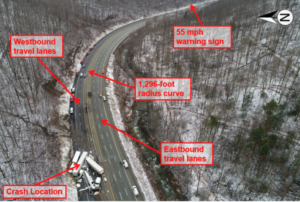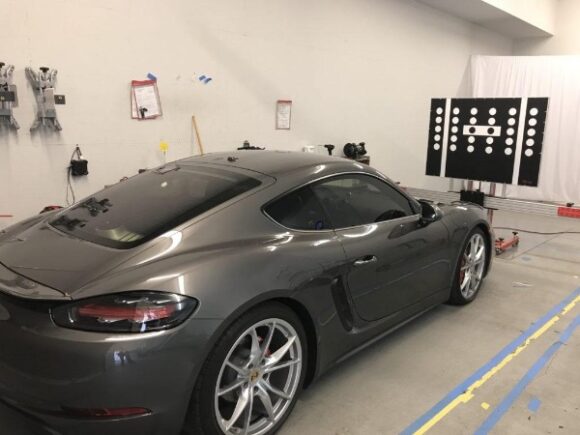The growing number of vehicles equipped with advanced driver assistance systems may be creating opportunities for mischief by collision repair shops.
A new report by CCC Intelligent Solutions found that the line-item charge for calibrating ADAS devices at a car dealer’s shop ranged from $46 for transporting the vehicle to the dealership to $12,058 for a “dealer sublet and calibration.”
“Given the range of what’s included (i.e. the calibration operation, an ADAS part, multiple operations, etc.) and the types of calibrations required depending on the OEM (original equipment manufacturer) and the system being calibrated, understanding whether the fees are appropriate is an ongoing challenge,” says the report, which was written by insights and analytics director Susanna Gotsch.
The cameras and radar and lidar sensors used for ADAS features, such as automatic emergency braking and blind-spot monitoring, typically have to be calibrated after a repair is made. Repair shops may also calibrate the devices before repairing a vehicle to determine if they are operable.
In early 2017, less than 5% of appraisals included an estimate line entry for a “scan/diagnosis/health check,” according to Gotsch’s report. That share had grown to 48.9% in the first quarter of 2021. The report says 70% of the appraisals with at least one scan entry included two scans, implying that both a pre-repair and post-repair scan was performed.
The number of ADAS devices repaired on each vehicle is also increasing. In fourth quarter of 2019, there was an average of 1.78 ADAS-related part on repairable appraisals. In the fourth quarter of 2021 there were 1.84, the report says.
The number of calibrations increase, of course, as the share of vehicles on the road with ADAS features increases. In 2016, 20 major automakers made a commitment to government safety regulators to make front crash prevention systems and automatic emergency braking standard on all vehicles sold after September 2022. In 2018, the National Highway Transportation Safety Administrated mandated rear backup cameras in all vehicles produced and sold in the United States.
Manufacturers reported that 80 percent of the passenger vehicles sold in 2021 were equipped with automatic emergency braking, up from 25% in 2017. The Insurance Institute for Highway Safety estimates that more than 60% of registered vehicles will be equipped with ADAS in 2024, up from 40% in 2019.

Manufacturers are pushing repair shops to calibrate ADAS devices. Volvo has stated that a scan must be completed before and after any work on one if its vehicles is done. Subaru says calibration should be performed after repairs for model year 2004 and later.
The cost of calibrations varies wildly, as does the verbiage used to describe the specific repair performed. CCC said the line-item tagged as “Calibration-Dealer” had 12,000 “distinct line entry text strings.” One of those text strings included the $12,058 charge mentioned earlier.
Charges for other line items were not any more consistent– and would give claims examiners plenty to puzzle over. The cost to “aim camera or sensor,” for example, ranged from $112 to $4,577. The cost of “calibration —radar” ranged from $351 to $6,455. “Calibration 360 degree”: $365 to $5,092.’
Frank Terlep, chief executive officer of Auto Techcelerators LLC, said he has never seen a $12,000 charge for ADAS calibration.
Calibration costs are based on the vehicle and the number of sensors/cameras that need to be calibrated on a vehicle,” he said in an email. “Based on the information we have, the typical vehicle requires 1.7 calibrations.”
“The price ranges I have seen are from $250 to $2,000.”
The cost of not calibrating ADAS devices can be unthinkable. The CCC report cites a National Transportation Safety Board investigation of a January 2020 multi-vehicle crash on the Pennsylvania Turnpike that killed five and injured 49 passengers on a motorcoach. While the bus driver’s excessive speed caused the crash, all three semi-trucks involved were equipped with forward-collision avoidance systems. The investigators determined that the system on one of the semi-trucks was not operational because of a misalignment of the radar.
“Calibration is crucial,” the CCC report says.
Photo at top courtesy of Lightning Auto Glass.
Was this article valuable?
Here are more articles you may enjoy.


 How Three New CMS Policies Impact Workers’ Comp Claims
How Three New CMS Policies Impact Workers’ Comp Claims  Florida And East Coast Will See Big Losses From More Cat 5 Storms, Researchers Say
Florida And East Coast Will See Big Losses From More Cat 5 Storms, Researchers Say  Hermès Heir Sues Arnault and LVMH in $16 Billion Suit Over Lost Shares
Hermès Heir Sues Arnault and LVMH in $16 Billion Suit Over Lost Shares  State Farm Sued Over Policies Backed by Distressed Insurer PHL
State Farm Sued Over Policies Backed by Distressed Insurer PHL 